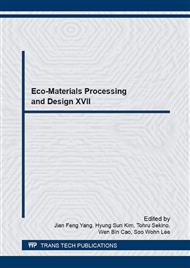[1]
S. Sun, C.B. Murry, Title of reference, Synthesis of monodisperse cobalt nanocrystals and their assembly into magnetic superlattices (invited), J. Appl. Phys. 85 (1999) 4325-9.
DOI: 10.1063/1.370357
Google Scholar
[2]
C.P. Bean, J.D. Livingston, Superparamagnetism, J. Appl. Phys. 30, (1959) 298-303.
Google Scholar
[3]
C. N. R. Rao and B. Raveau, Transition Metal Oxides 2nd edn (1995) (Weinheim: Wiley–VCH).
Google Scholar
[4]
T. Shen, R. Weissleder, M. Papisov, A. Bogdanov and T. J. Brady, Monocrystalline iron oxide nanocompounds (MION): Physicochemical properties, Magn. Reson. Med. 29 (1993) 599-604.
DOI: 10.1002/mrm.1910290504
Google Scholar
[5]
C. V. Bowen, X. W. Zhang, G. Saab, P. J. Gareau and B. K. Rutt, Application of the static dephasing regime theory to superparamagnetic iron-oxide loaded cells, Magn. Reson. Med. 48 (2002) 52-57.
DOI: 10.1002/mrm.10192
Google Scholar
[6]
W. Kim and F. Saito, Effect of grinding on synthesis of MgAl2O4 spinel from a powder mixture of Mg(OH)2 and Al(OH)3, Powder Technol. 114 (2001) 12-16.
DOI: 10.1016/s0032-5910(00)00208-4
Google Scholar
[7]
M. E. Akerman, W. C. W. Chan, P. Laakkonen, S. N. Bhatia and E. Ruoslahti, Nanocrystal targeting in vivo, Proc. Natl Acad. Sci. USA 99 (2002) 12617-12621.
DOI: 10.1073/pnas.152463399
Google Scholar
[8]
W. U. Huynh, J. J. Dittmer and A. P. Alivisatos, Hybrid Nanorod-Polymer Solar Cells, Science. 295 (2002) 2425-2429.
DOI: 10.1126/science.1069156
Google Scholar
[9]
U. H¨afeli, W. Sch¨utt, J. Teller and M. Zborowski (ed), Scientific and Clinical Applications of Magnetic Carriers (1997) (New York: Plenum).
Google Scholar
[10]
M. M. Maye, Y. B. Lou and C. J. Zhong, Core−Shell Gold Nanoparticle Assembly as Novel Electrocatalyst of CO Oxidation, Langmuir. 16 (2000) 7520-7525.
DOI: 10.1021/la000503i
Google Scholar
[11]
J. M. Tarascon and M. Armand, Issues and challenges facing rechargeable lithium batteries, Nature. 414 (2001) 359-364.
DOI: 10.1038/35104644
Google Scholar
[12]
F. Patolsky, Y. Weizmann, E. Katz and I. Willner, Magnetically Amplified DNA Assays (MADA) Sensing of Viral DNA and Single-Base Mismatches by Using Nucleic Acid Modified Magnetic Particles, Angew. Chem. Int. Edn. 42 (2003) 2372-2376.
DOI: 10.1002/anie.200250379
Google Scholar
[13]
C. A. Ross, Patterned Magnetic Recording Media, Annu. Rev. Mater. Res. 31 (2001) 203-207.
Google Scholar
[14]
S. Krupiˇca and P. Nov´ak, Oxides Spinel in Ferromagnetic Materials vol 3, ed E P Wohlfarth (Amsterdam: North-Holland) chapter 4 (1982).
Google Scholar
[15]
R. E. Vandenberghe and E. De Grave, 57Fe Mössbauer effect study of Mn-substituted goethite and hematite, M¨ossbauer Spectroscopy Applied to Inorganic Chemistry vol 3 , ed G J Long and F Grandjean (New York: Plenum) chapter 3 (1986).
DOI: 10.1007/bf02399440
Google Scholar
[16]
M. P. Pileni, Structure and Reactivity in Reverse Micelles, Elsevier, Amsterdam Chapter 1 (1989).
Google Scholar
[17]
B. K. Paul and S. P. Moulik, Microemulsions: an overview, J. Dispersion Sci. Technol. 18 (1997) 301-306.
Google Scholar
[18]
V. pillai, P. Kumar, M. J. Hou, P. Ayyub, and D. D. Shah, Preparation of nanoparticles of silver halides, superconductors and magnetic materials using water-in-oil microemulsions as nano-reactors, Adv. Colloid Interface Sci., 55 (1995) 241-246.
DOI: 10.1016/0001-8686(94)00227-4
Google Scholar
[19]
Ph. Monnoyer, A. Fonseca, J. B. Nagy, Preparation of colloidal AgBr particles from microemulsions, Colloid Surf. A: Physicochemical Eng. Aspects, 100, (1995) 233-237.
DOI: 10.1016/0927-7757(95)03187-i
Google Scholar
[20]
Y. Yafet and C. Kittel, Antiferromagnetic Arrangements in Ferrites, Phys. Rev. 87 (1952) 290-295.
DOI: 10.1103/physrev.87.290
Google Scholar


